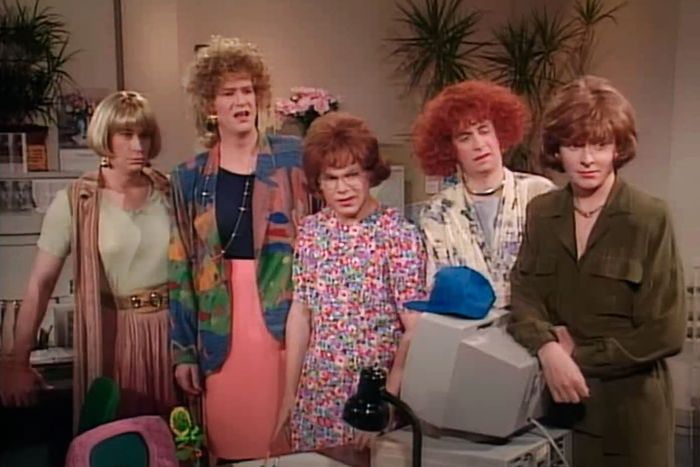
So you want to be a Kids in the Hall keener?
\ ˈkēnər \
(Canadian slang, noun) Individual eager to demonstrate knowledge or participate enthusiastically in school, church, seminars, etc. Like nerd, geek, brown-noser, smartypants, etc. but with more emphasis on willingness and enthusiasm and less on social inadequacy, sycophancy, or natural ability.
Then listen to your old man.
The Kids in the Hall is back from the dead (literally — they ended their original 1988–1995 series getting buried alive in a mass grave), and they’re introducing a whole new generation of comedy nerds to their brand of alt, intelligent, surreal, goofy comedy. In the decades since their CBC-HBO sketch show went off the air, they’ve released a cult-fave movie, gone on numerous live comedy tours, and had a limited-run revival with 2010’s Death Comes to Town. Over the course of 102 episodes in their original run, Dave Foley, Bruce McCulloch, Kevin McDonald, Mark McKinney, and Scott Thompson were irascible comedy scamps ahead of their time and deft at political subversion, gender fuckery, and poo jokes in equal measure. Upon rewatch, this show is a nuclear Twinkie: just as fresh as the day it was made and perversely delicious. If you see the letters KITH and only think of shoes, here is a 22-step field guide of tropes to watch out for from the Citizen Kane of sketch comedy.
30 Helens Agree
Only nine out of ten doctors agree on the leading brand of toothpaste, but 30 out of 30 Helens agree on everything from tattoos to coleslaw. (Except for that one time only 29 Helens agreed on the subject of promptness because Helen Fournier was running late.)
A.T. & Love
This is the fictional corporation where all of the Kids in the Hall’s office drag takes place, the precursor to your GloboChems and Cincos. There are the gossipy queens of the typing pool Cathy and Kathie (McCulloch and Thompson, unclear who’s who); their temp whipping girl Tanya (McKinney); company man Danny Husk (Thompson); chatty mailroom guy Stan (McKinney); and the boss, played by Foley in a fat suit and bald cap, sometimes with a mysterious brown liquid leaking from his mouth. And adjacent to but not an affiliate of A.T. & Love are lawyers the Geralds.
Bruce and Mark’s Dumb Cops and Slick Hucksters
If KITH have 30 seconds to fill between sketches, you better believe McCulloch and McKinney’s dipshit TPS officers are on the case. Give them five minutes, though, and they’ll put on their $1,100 suit jackets and try to sell you on a pyramid scheme, canned meat product, or electric organ. These sales-pitch sketches are one example of a technique KITH really pioneered ahead of shows like ITYSL or Tim & Eric: When in doubt, fill a sketch with a fake product and/or senior citizens.
Bruce’s Little Punks and Twerps
No, this isn’t the name of a spinoff sketch series. It’s an acknowledgment that no one on earth is playing combative little punks and annoying little twerps better than McCulloch. They can be meek (“My Pen”) or delusionally bold (“Bobby Versus Satan”), and often they’re rarin’ for a fight that they’re bound to lose (“Eradicator,” “Cincinnati Kid,” “Stay Down”). McCulloch can play a hundred shades of twerp, from loathsome creep Cabbage Head to overly chatty latchkey kid Gavin. He gives especially affectionate performances as mulleted punk rockers; see “Into the Doors,” in which he played the Jack Black High Fidelity character years before High Fidelity.
Buddy Cole
Thompson’s greatest character is a folk hero, trailblazer, iconoclast, and chaos agent. The worldliest Canadian to ever live, Buddy Cole is a unique character in sketch history. He’s hypersmart, hypersexual, unabashedly flaming, and irreverent at a time when there weren’t exactly a million other characters on TV dispensing five-minute monologues about cruising and dropping James Baldwin references. What makes Buddy a fully balanced one-queen force is how he sprinkles his satire with the surreal. Take “Dinosaurs,” a monologue about queer social life and about an influx of T. Rexes and pterodactyls going around biting his friends’ limbs off, or the time he coached a lesbian softball team (the Sappho Sluggers) in what was essentially a live-action Bugs Bunny sequence. Canadian television funding has never gone to a worthier cause.
Canada
Above all, KITH are good Canadian subjects of the queen. Or at least Thompson’s version of her.
Chicken Lady
A half-chicken, half-woman with no brain cells and a huge libido who explodes into a cloud of feathers when she orgasms. Obviously that would become the mainstream breakout character. What don’t you understand about this?
The Darcy Pennell Show
McDonald’s completely incompetent talk-show host is underrated but extremely funny. Can’t pronounce a name to save her life, poor dear.
Darill
McKinney’s ponytailed, ambiguously accented Darill feels like a Frasier character. This is ultimate praise.
Francesca Fiore and Bruno Putz-Jones
These fake foreign-film stars make movies that are impossible to follow but hard to look away from. Thompson plays the mysterious and glamorous Uruguayan beauty Francesca, and Foley plays Bruno, her lover-pimp-co-star. They first emerge in a sketch that folds reality inside out, and over the course of their appearances, we get a good look at their oeuvre, from Senhora Sete to Spy Models.
German Expressionism
A lot of existential dread and paranoia going on in some of these. A lot of creativity with the camera and filmmaking style. Brainy stuff. Did you know that before KITH, Foley and McDonald were on an improv team called Uncle Vanya and the Three Sisters? Drive My Car found shaking.
Gordon and Fran
McCulloch and Thompson’s middle-aged suburban couple is delightfully lived-in; you get the sense that there’s a full two-act play’s worth of backstory behind the marriage of considerate and fretful Fran and blustery Gordon. I could choose from a zillion sketches where the Kids play frazzled housewives, but these are the sketches I always come back to. Even though Thompson plays the wife, it’s McCulloch who’s doing the drag here, performing a very certain type of always low-key angry and stressed domesticized masculinity. Decades before @dril, Gordon was spewing lines like, “A man works all day — he expects a normal ham meal, not goddamn bastard brine!”
Headcrusher
The Kids in the Hall had a good number of sketches that utilized the camera in ways that felt more surprising than the average sketch show. Sometimes that meant cinematic, lyrical stuff like “My Pen” … and sometimes that just meant McKinney’s Headcrusher squeezing his finger and thumb in the foreground to crush businessmen, yuppies, and bullies like ants. The Headcrusher’s lore expanded over the series as the Kids came up with silly new ways to play with depth of field: there’s “Nobody Home,” finger rehab, and an epic battle with his rival, the Facepincher (McDonald).
Hotel La Rut
You would think that Foley makes for the prettiest girl of all the Kids — after all, he is one of comedy’s prettiest boys. But you would be sadly mistaken because McKinney’s languid French whore Sylvie exists, wasting away blondely in front of a vanity, thinking about Tony, wondering where he could be, who he’s with, what is he thinking … is he thinking of her? And whether he’ll ever return someday. Her friend Michelle (Thompson) is wondering the exact same thing. My headcanon is Monique the Pyromaniac is her identical twin.
Kevin and Dave’s Frenzied Pairings
McDonald and Foley had been performing together long before the troupe formed, so whenever the two pair up for a sketch, things get especially … sizzly. It takes a creative partnership built on trust and shared creative language to dream up characters like Jerry Sizzler and his sister, Jerry Sizzler, two escaped mental patients in bathrobes and stolen wigs with the tags still on, starting their lives afresh as lounge singers and bank robbers.
There’s also Simon and his manservant Hecubus, eeeeeevil hosts of the Pit of Ultimate Darkness, and hapless vaudevillians McGillicuddy and Green (not to be confused with McDonald’s other hapless vaudevillian, Mr. K). And then there’s “Premise Beach,” a segment where Foley and McDonald throw themselves into the most half-baked premises they can dream up. The most elaborate of the premises is “Shitty Soup,” which deftly pivots into a fourth-wall-breaking sketch that Thompson runs away with.
The King of Empty Promises
Almost forgot to include this guy on the list. Slipped my mind.
Meta Sketches About Sketch Writing
“Premise Beach” is only the tip of this iceberg.
Monologues
Every member of KITH can pull off a mean monologue, both in character and out. They make SNL and late-night monologues sound like kindergarten graduation speeches, and they go well beyond Buddy Cole. Foley is especially skilled at giving clear-eyed deliveries of psychotic takes. They’ve got multiple soliloquies about how much it sucks to be a cyclist in Toronto (plus ça change …). But only “Bank People” has dance breaks.
Paul Bellini
You know how podcasts will often have an engineer or producer that eventually, casually becomes like the show’s bonus host — always there in the background and a beloved treat when they get on mic? Paul Bellini is KITH’s version of that. Bellini, who would go on to have a column in defunct Toronto gay magazine Fab, is Thompson’s writing partner on the show and wrote on almost every episode, the two of them instilling the comedy with a distinct queer sensibility. As the series went on, they’d throw him into sketches more and more, always wearing only a towel and mostly silent, until they started holding sweepstakes for fans to touch Bellini’s exposed belly or eat breakfast with him at an airport. After Shania Twain, he is Timmins’s most famous export. And in the future, mankind will know God was a “ridiculous, stupid sham” but will remember and worship Bellini.
Songs
What would Kids in the Hall be without that surf-guitar theme music? And what would it be without musical sketches? And what would all these Daves be without their moms?
Steps
KITH infused their comedy with gay themes and characters from their very first episode in 1988 onward in sketches about closeted celebrities, representational politics, homophobia, or just regular relationship foibles. And just about every other sketch was about mocking straight culture: Their straight husband and businessman characters come across more like drag than their drag characters. Most of the Kids are straight, but Thompson and Bellini’s impact was indelible, and the whole cast had a hand in bringing these closely observed characters to life. Like in “Steps,” a recurring sketch about a friend triad who hangs out on the stoop of a coffee shop around Church and Wellesley and talks about, as Foley pronounces it, the big “iss-yoos,” including AIDS and gay marriage. There’s Smitty (McDonald), a neurotic Louis Ironson type, Riley (Foley), a freakin’ scamp, and Butch (Thompson), the sweet idiot. To quote writer Daniel Ortberg, “In the hands of lesser men, this would not be a loving, affectionate, insider-y tweak at Canadian gay (stairwell) culture; it would be cringe-inducing gay drag. Not so the Kids.”
Surrealism
If you haven’t figured it out by this point, KITH revels in the absurd. Either the Pear Dream speaks to you or it doesn’t.
And there you have it: 22 things to know before you watch the new Kids in the Hall. Now go on, be free. Bye, Mr. Stevenson!


